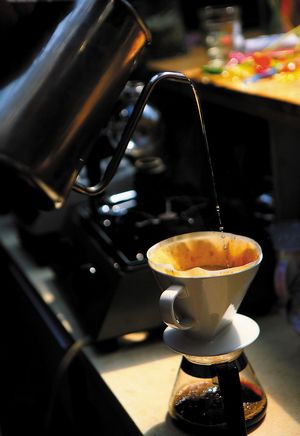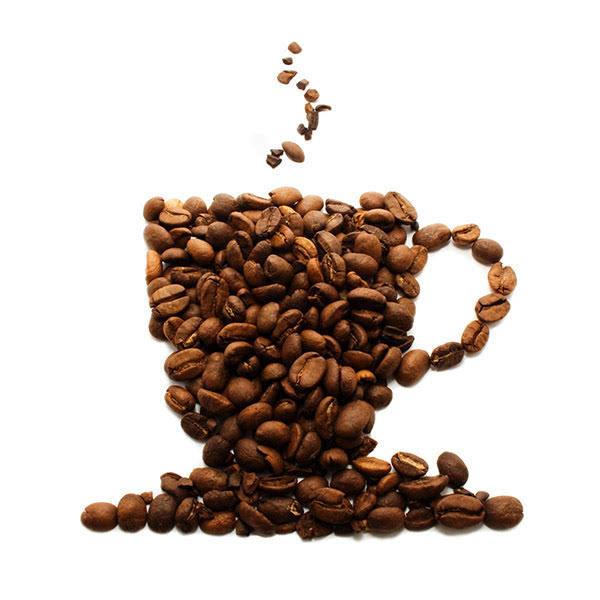How to brew Kenyan coffee, introduction to the characteristics of Kenyan coffee
Follow the caf é (Wechat official account vdailycom) and found that Beautiful Cafe opened a small shop of its own.
How to brew Kenyan coffee
[Kenya Dou]
13g, the cup measures the baking degree (belongs to 1 burst bean)
93 degrees water temperature (cooling by changing pots, the loss of cold water to hot water is 2%)
The ratio of powder to water is 16.66.
After grinding, it is corrected by No. 20 screen.

[water consumption]
Conversion according to the ratio of gouache: 13 grams x 16.66 grams 216.58 grams
Change it to 93 degrees hot water: 216.58 X 0.98g.
Therefore, the total amount of water is 212.25 grams, and the water is cut off once at 70% of the total water (148.6 grams).
Stage 1 [steaming]
1 burst beans, I am used to steaming with 15% of the total water. Therefore, the amount of steaming water in this cup of Kenya is 212.25 X 0.15 and 31.8 grams. But there are requirements for steaming currents and circles.
The smallest water flow in the hand flushing pot begins to circle after 2 seconds of water injection at the center point, must go to the edge, and then go back to the center point, about 8 times, requiring that the right amount of water is about 31.8 grams. There can be a deviation of a few grams, but all powders must be wet to water. To do this, you must practice the smallest flow + circle.
Please note: the tiniest flow of different hand pots will be different, and try to be as thin as possible. ]
For steaming time, individuals often look at the powder layer formed by steaming. If no bubbles come out, it means that the steaming time is enough, and you can inject water at the central point. Of course, many people are used to using timers for 30-40 seconds, so they can't cope with different beans and different freshness. Resulting in the possibility of steaming some defective smell out. Beginners can use timers temporarily, but it is recommended to observe the powder layer for a long time.
[please note: if you steam quickly with a large current, no bubbles will appear. If you use fine water flow, but the circle is irregular, the water flow is intermittent, and there will be no bubbles coming out. ]
The second stage [washing away the powder layer formed by steaming]
A total of six concentric circles are needed at this stage. After the smallest flow of water is injected into the center point by hand for 2 seconds, the concentric circle is around the first circle, and then each concentric circle is enlarged 1 turn accordingly. To the fifth concentric circle, about 12.5px away from the wall of the filter cup, all powder layers will be wet to water and washed away. Then, go back to the fourth concentric circle. The third stage will explain in detail how to circle the third lap.
After circling 6 concentric circles, the electronic claim will show that the amount of water is about 70-80 grams (including 31.8 grams of water used for steaming). If it exceeds 80 grams, the flow is too large, and you must practice the smallest flow + circle. Use this thin water to slowly circle and disperse the powder layer formed by steaming, and all the powder is wet to the water, determining the direction of the taste. The first feeling of drinking coffee is that the taste is distributed to the whole mouth, and every taste bud can feel the coffee, which can improve the cleanliness and sweetness.) This stage of the flow requirements is the lowest, even if you break the flow does not affect the taste, as long as it can be wet to all the powder. If the filter paper is washed on the filter paper during the circle at this stage, the water on the filter paper will be absorbed by the powder layer, because when the fine water flows around, the water absorption rate of the powder layer is slow and the water in the powder layer is not saturated.
On the contrary, hand flushing is popular in China. The water is also injected at the central point, but the flood flows around 2-3 times, and the water in the powder layer is saturated. The large current has a great impact on the powder layer, and many people do not dare to go to the extreme edge, so they can only circle around the center point and the middle part of the filter cup wall. the large water flow will quickly push up the powder layer, and some of the steaming powder layer on the far side will be relatively dry relative to the central point, resulting in insufficient extraction. (taste trend: the first taste of drinking coffee is included in, and the coffee liquid flows directly down to the throat, resulting in a strong taste and easy to have raw and mixed smell.)
You can compare and feel the difference in the direction of the taste.
Stage 3 [water injection in the third concentric circle]
The third concentric circle is the middle part between the center point of the filter cup and the filter cup wall, which just avoids the outlet hole at the bottom of the filter cup.
After the smoldering powder layer is washed away and wound inward to the third concentric circle, the flow increases to 150% of the previous smallest flow. You will see that the powder below will continue to arch up, indicating a strong stirring, and then inject water slowly around the third circle (note that it is a slow circle), about 4-5 times to reach 148.6 grams. At this time, the water is cut off once (at this time, the color of the second circle and the center point of the powder layer is darker than other places, and the position of the third circle is clearly felt. If Chong 2 burst beans, the master can rush out of the heart-shaped pattern.
The biggest feature of stage 3: after increasing the current, there must be a rush of powder. If not, please increase the current. ]
This forms an air channel and a powder layer wall, which facilitates the entry of air and allows the previously extracted coffee liquid to flow down through gravity, and the powder layer wall can seal off the miscellaneous smell and highlight cleanliness. If you go around the second circle and the central point, there is an air channel, but there is no powder layer wall, when you go around the central point, gravity will make some smells flow down, and the powder layer will be messed up, of course. If you only circle the third concentric circle at this time, avoiding the outlet hole at the bottom of the filter cup, and the coffee powder forms a powder layer wall along the third concentric circle, sealing off the miscellaneous smell, you will feel that the smell is very clear or clean.
Stage 4 [150% of the smallest flow before the flow is maintained, only injecting water in the third concentric circle]
After 148.6 grams of water is cut off, the water level of the powder layer will drop. When the bottom is almost reached, the position of the filter cup handle corresponding to the third concentric circle is used as the water injection point, the flow keeps 150% of the previous smallest flow, circle slowly, and only inject water in the third concentric circle. Generally speaking, around 3-4 times can reach 212.25 grams, stop water injection, extraction end.
If there are no baking defects or raw bean defects in Kenya, remove the filter cup when it is almost finished. If there are defects or gas beans, after the injection of water, that is, remove the filter cup, this is the correction extraction.
Kenyan coffee fruit
Don't underestimate the small farmers in Kenya, they are just like ants, and their overall production capacity is higher than that of large farms, about six to four, which is quite rare in bean-producing countries. Kenyan coffee is widely appreciated by connoisseurs, thanks in large part to small farmers guarding the foothills and producing high-quality coffee. In addition, Kenya beans must have a strict grading system. Coffee beans taken out by washing plants are divided into five grades according to size, shape and hardness, with the highest being PB, followed by AA++, AA+, AA and AB. This grading system is similar to Colombia, mainly in terms of particle size and shape, but selling well does not necessarily lead to good flavor. This is what coffee fans should know. The current international evaluation of Kenyan beans is not as good as in previous years. It is believed that this has something to do with the abnormal climate, which is not conducive to the growth of coffee, but the matter is not so simple. This is related to the Kenyan authorities' efforts to promote the new variety Ruiru11 with stronger disease resistance and higher yield per unit. According to the taste test, the new variety with higher economic value has a worse flavor than the traditional variety, and to make matters worse, Ruiru11 is about to replace the traditional Arabica and Bourbon varieties. In addition, the quality of coffee is declining, the auction price is not good, and the income of small farmers is reduced. Coupled with the fact that the coffee management bureau is not a paradox, farmers' enthusiasm for coffee will be greatly reduced, which will of course affect the quality of coffee. Moreover, Kenya's outstanding washing technology has also declined, which is the killer of strangling quality.
Important Notice :
前街咖啡 FrontStreet Coffee has moved to new addredd:
FrontStreet Coffee Address: 315,Donghua East Road,GuangZhou
Tel:020 38364473
- Prev

Is there any sweetness in Kenyan coffee? Kenya Coffee introduction
Following Cafe Review (Wechat official account vdailycom) found that Kenyan Coffee has a wonderful fruit flavor, with a BlackBerry and grapefruit flavor, which is a favorite of many coffee glutton. This coffee has an excellent medium purity, crisp and refreshing taste. It has a fresh flavor and is most suitable for drinking iced coffee in summer. Taste
- Next

Distribution of coffee producing areas in Kenya, introduction of Kenyan coffee
Kaibei (official Wechat account vdailycom) found that Beautiful Cafe opened a small shop of its own. The upland washed Arabica beans produced in Kenya are one of the best coffee in the world in terms of quality. The coffee industry in Kenya is of good quality and consistent under the strict control of the Kenya Coffee Agency. Kenyan coffee is famous for its strong fruit taste, with lemon and citrus acid.
Related
- Detailed explanation of Jadeite planting Land in Panamanian Jadeite Manor introduction to the grading system of Jadeite competitive bidding, Red bid, Green bid and Rose Summer
- Story of Coffee planting in Brenka region of Costa Rica Stonehenge Manor anaerobic heavy honey treatment of flavor mouth
- What's on the barrel of Blue Mountain Coffee beans?
- Can American coffee also pull flowers? How to use hot American style to pull out a good-looking pattern?
- Can you make a cold extract with coffee beans? What is the right proportion for cold-extracted coffee formula?
- Indonesian PWN Gold Mandrine Coffee Origin Features Flavor How to Chong? Mandolin coffee is American.
- A brief introduction to the flavor characteristics of Brazilian yellow bourbon coffee beans
- What is the effect of different water quality on the flavor of cold-extracted coffee? What kind of water is best for brewing coffee?
- Why do you think of Rose Summer whenever you mention Panamanian coffee?
- Introduction to the characteristics of authentic blue mountain coffee bean producing areas? What is the CIB Coffee Authority in Jamaica?

